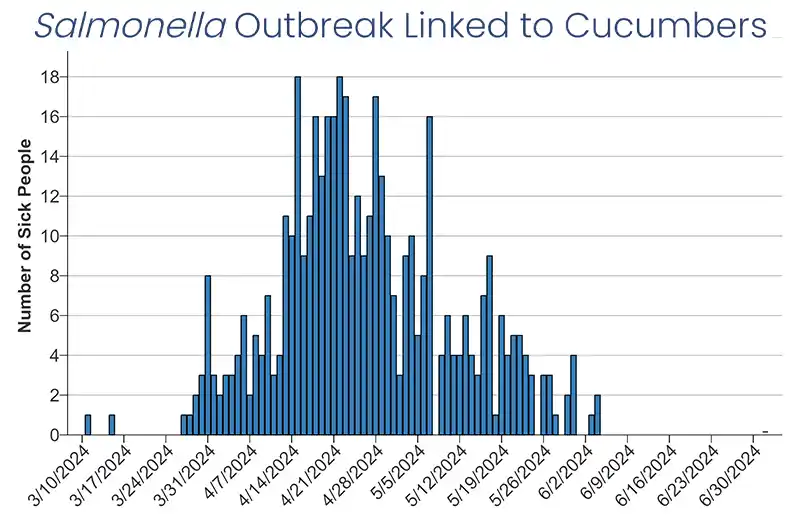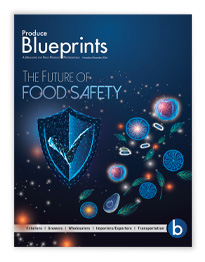July 2, 2024 — CDC, public health and regulatory officials in several states, and the U.S. Food and Drug Administration (FDA) are collecting different types of data to investigate a multistate outbreak of Salmonella Africana and Salmonella Braenderup infections. Epidemiologic, traceback and laboratory data show that cucumbers were contaminated with Salmonella and made people sick.
CDC and FDA combined these two outbreak investigations as they shared several similarities, including where and when illnesses occurred, the demographics of ill people and the foods they reported eating before they became sick.
Epidemiologic Data
As of July 2, a total of 449 people infected with one of the outbreak strains of Salmonella Africana and Salmonella Braenderup have been reported from 31 states and the District of Columbia (see map). Of these illnesses, 215 people were infected with the newly added Salmonella Braenderup strain. Illnesses started on dates ranging from March 11, 2024, to June 4, 2024 (see timeline). Of 360 people with information available, 125 have been hospitalized and no deaths have been reported.
The true number of sick people in this outbreak is likely much higher than the number reported, and the outbreak may not be limited to the states with known illnesses. This is because many people recover without medical care and are not tested for Salmonella. In addition, recent illnesses may not yet be reported as it usually takes 3 to 4 weeks to determine if a sick person is part of an outbreak.
Public health officials collect many different types of information from sick people, including their age, race, ethnicity, other demographics, and the foods they ate in the week before they got sick. This information provides clues to help investigators identify the source of the outbreak.
The table below has information about sick people in this outbreak (“n” is the number of people with information available for each demographic).
| Demographics | Information |
|---|---|
| Age (n=447) | Range from <1 to 94 years Median age of 45 |
| Sex (n=445) | 66% female 34% male |
| Race (n=360) | 84% White 11% African American/Black <1% Native American or Alaska Native 3% Asian 0% Native Hawaiian or other Pacific Islander <1% Middle Eastern/North African <1% reported more than one race |
| Ethnicity (n=351) | 90% non-Hispanic 10% Hispanic |
State and local public health officials are interviewing people about the foods they ate in the week before they got sick. Of the 188 people interviewed, 129 (69%) reported eating cucumbers. This percentage was significantly higher than the 50% of respondents who reported eating cucumbers in the FoodNet Population Survey—a survey that helps estimate how often people eat various foods linked to diarrheal illness. This difference suggests that people in this outbreak got sick from eating cucumbers.
Laboratory and Traceback Data
Public health investigators used the PulseNet system to identify illnesses that may have been part of this outbreak. CDC PulseNet manages a national database of DNA fingerprints of bacteria that cause foodborne illnesses. DNA fingerprinting is performed on bacteria using a method called whole genome sequencing (WGS).WGS showed that bacteria from sick people’s samples are closely related genetically. This means that people in this outbreak likely got sick from the same type of food.
WGS analysis of bacteria from 214 people’s samples had no predicted resistance; bacteria from 235 people’s samples predicted resistance to one or more of the following antibiotics: amoxicillin-clavulanic acid, ampicillin, azithromycin, cefoxitin, ceftiofur, ceftriaxone, ciprofloxacin, fosfomycin, and tetracycline. More information is available at the National Antimicrobial Resistance Monitoring System (NARMS) site. Most people with Salmonella illness recover without antibiotics. However, if antibiotics are needed, some illnesses in this outbreak may be difficult to treat with some commonly recommended antibiotics and may require a different antibiotic choice.
FDA’s traceback investigation identified Bedner Growers, Inc., in Florida as a supplier of cucumbers in this outbreak. This one grower does not account for all illnesses in this outbreak.
FDA collected samples at the grower in Florida and identified Salmonella Braenderup in untreated canal water. WGS determined that the Salmonella found in the water is the same strain of Salmonella Braenderup that made people in this outbreak sick. Additional soil and water samples collected at Bedner Growers, Inc. were positive for other strains of Salmonella. CDC and FDA are looking to see if these strains have caused illness in people.
Public Health Actions
Bedner Growers, Inc. in Florida, where the positive sample was collected, is no longer growing and harvesting cucumbers for the season.



